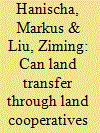| Srl | Item |
| 1 |
ID:
156452


|
|
|
|
|
| Summary/Abstract |
Functioning land markets are necessary for an increase in off-farm employment. However, there is limited empirical evidence on the impact of land transfer on off-farm employment in rural China. This paper investigates the drivers of households' cooperative membership, which is equivalent to transferring land through land cooperatives, and its impact on off-farm employment. Using a two-step control function approach and data from Suzhou and Yangzhou (Jiangsu province), we do not find a general effect of cooperative membership on household heads' current off-farm employment, though the effect is large for households which had surplus agricultural labor before cooperative initiation. The effect is also positive and large for household heads without off-farm experience and households located in Yangzhou. Policy-makers should be aware of the distributional consequences of these heterogeneous effects.
|
|
|
|
|
|
|
|
|
|
|
|
|
|
|
|
| 2 |
ID:
187356


|
|
|
|
|
| Summary/Abstract |
This paper studies the impact of education on domestic terrorism in Asian countries from 1970 to 2018. A control function approach is utilized to address the endogeneity of education on terrorism. Generally speaking, results show that education promotes domestic terrorism in Asia. Negative binomial regressions with and without control function are run for other parts of world to examine whether the patterns in Asia hold worldwide. Other important determinants of domestic terrorism in Asia include regime type, ethnic fractionalization, linguistic fractionalization, religious fractionalization, GDP per capita, and trade openness. This paper contributes to the literature by 1) applying a control function approach to control for possible endogeneity of education on terrorism, 2) analyzing exclusively Asia, a region where terrorism has been increasing rapidly over the last decade, (3) and focusing on domestic terrorism.
|
|
|
|
|
|
|
|
|
|
|
|
|
|
|
|